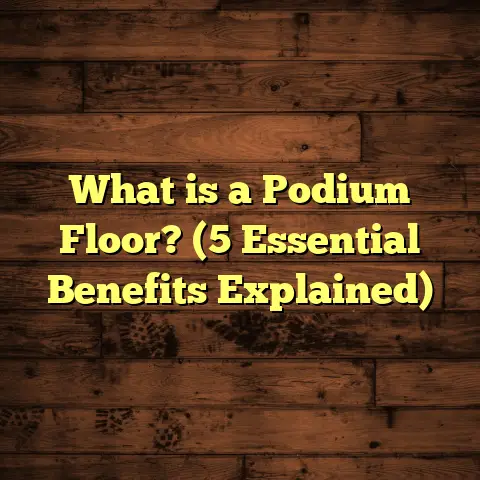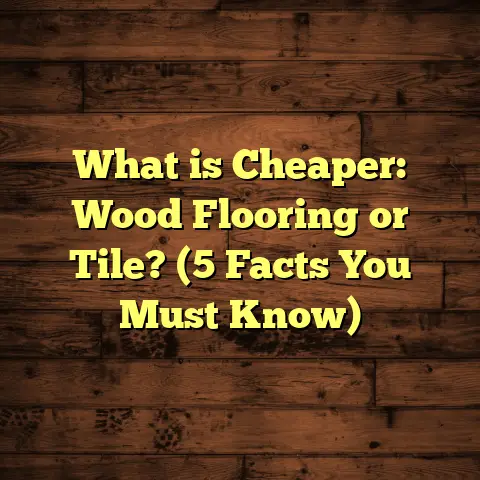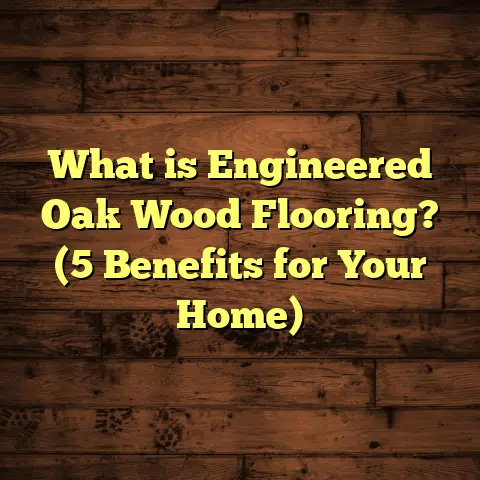What is the Difference Between Hardwood Floor and Slab? (5 Key Points to Maximize Your Home’s Value)
Trends in home flooring have shifted a lot in recent years. From what I’ve observed working with homeowners and contractors, the debate between hardwood floors and slab flooring options comes up more frequently than ever. Everyone wants their floor to not only look great but also add real value to their home.
I want to share everything I’ve learned about these two very different flooring choices. Whether you are remodeling your current home or buying one, understanding the differences can help you make a smart investment.
Let’s start by clearing up what “hardwood floor” and “slab” flooring really mean, then we’ll jump into the five key points that can help you maximize your home’s value.
What Is Hardwood Floor and What Is Slab Flooring?
Hardwood flooring is exactly what it sounds like: floors made from solid wood planks sourced from trees such as oak, maple, cherry, or hickory. These planks are milled from whole logs and cut into boards that are installed in your home.
Hardwood floors have a natural grain pattern and warm tones that create a timeless look. They are highly durable and can be sanded and refinished multiple times over their lifetime, which can easily span several decades.
Slab flooring usually refers to either a concrete slab poured at the foundation level or large-format slabs of natural stone such as marble, granite, or slate laid on the floor. Sometimes people also use the term slab for large porcelain tiles designed to look like stone or concrete.
Concrete slab floors tend to be smooth, flat surfaces with a cool, industrial aesthetic. Stone slabs bring in natural variation and elegance but require sealing and special care.
To give you a better sense of scale: hardwood planks typically come in widths from 2-1/4” to 7” or more, while stone slabs can be massive pieces covering several square feet at once.
1. Material & Aesthetic Differences: Warmth vs. Solidity
When I first got into flooring work, I noticed how much hardwood floors instantly change the feel of a room. They bring warmth you can see and feel — that natural grain and texture is something no other material replicates perfectly.
Hardwood comes in countless species and finishes. Oak remains popular for its strength and classic look. Maple offers a lighter tone with a subtle grain. Cherry darkens beautifully with age. And exotic woods like Brazilian cherry or teak bring rich color variations.
I remember installing solid oak floors in an old Victorian house. The owner was thrilled because the wood brought out the character of the home’s architecture. Over time, as the wood darkened slightly, it developed a beautiful patina that photos just can’t capture.
Slab floors like polished concrete or stone give off a very different vibe — sleek, modern, and sometimes even cold if you’re not used to it. This style has become trendy in urban lofts and minimalist homes. The smooth surface reflects light nicely and feels very clean.
One client chose large-format marble slabs for their kitchen floor. It was stunning but required area rugs for comfort because walking barefoot felt cold and hard. Another client opted for polished concrete in a sunroom; it created an industrial-chic look that fit perfectly with their furniture.
The National Wood Flooring Association (NWFA) reports hardwood floors can increase home value by 2% to 5% on average. Meanwhile, homes with high-end stone or concrete slab floors often see similar value boosts but generally attract buyers looking for modern design.
Hardwood Grain & Color: More Than Just Looks
The beauty of hardwood goes beyond color — it’s about texture too. Different cuts reveal different grain patterns:
- Plain sawn shows wide grain patterns with “cathedral” shapes.
- Quarter sawn displays narrower stripes and more dimensional stability.
- Rift sawn offers straight grain with minimal flecking.
These details affect how light plays on the floor and how durable it is against warping.
Stone & Concrete Slabs: Unique Textures
Stone slabs vary greatly depending on the type:
- Marble: Luxurious veining, glossy finish but softer and prone to scratching.
- Granite: Harder, more speckled appearance.
- Slate: Matte finish with layered textures.
- Concrete: Can be polished to a high gloss or left matte; can include decorative stains or aggregates for visual interest.
Each slab type brings its own personality but requires different levels of upkeep.
2. Installation Complexity & Time
I’ve installed dozens of hardwood floors over the years. The process involves carefully acclimating wood to the room’s humidity before installation to prevent expansion or shrinkage later on. Planks are then nailed, stapled, or glued down depending on the subfloor type.
A typical hardwood floor installation takes about 3 to 7 days for an average-sized room (around 300 sq ft). The biggest challenge is ensuring tight seams without gaps and a level surface.
In contrast, slab floors require a more involved process:
- Concrete slab: Pouring a concrete slab involves preparing forms, laying reinforcement (rebar or mesh), pouring the concrete mix evenly, then letting it cure properly for up to 28 days before finishing touches.
- Stone slabs: These large slabs must be cut precisely to fit the space, which often involves custom fabrication off-site. On-site installation requires careful leveling and grout work between slabs.
I worked on a project where a client wanted a polished concrete slab in their basement. We had to wait nearly a month for curing before finishing could start — much longer than any hardwood job I’ve done.
Subfloor Preparation Matters
Hardwood floors require plywood or concrete subfloors that are level and dry. Any imperfections can cause squeaks or uneven boards later on.
Slabs like concrete sometimes serve as the subfloor themselves if poured directly on grade or over insulation layers. Stone slabs generally need an even mortar bed underneath for secure adhesion.
DIY vs Professional Installation
While some hardwood floor installations can be DIY-friendly with proper tools, slab flooring almost always requires professional installers due to heavy materials and complex pour or cut techniques.
3. Longevity & Maintenance
Hardwood floors are known for lasting generations if cared for properly. You will see scratches or dents over time — pets running around or moving furniture can leave marks. But here’s where hardwood shines: you can sand down the surface multiple times to remove damages and restore that fresh look.
According to data from the Hardwood Federation, hardwood floors can withstand sanding and refinishing up to seven times, extending their life well beyond 50 years in many cases.
In my experience, homeowners who invest in quality hardwood tend to keep their floors for life unless they remodel completely.
Slab floors are extremely durable but have different maintenance concerns:
- Concrete slab floors are nearly indestructible but can develop hairline cracks if the foundation shifts or if poured improperly.
- Stone slabs are very hard-wearing but porous stones like marble require regular sealing to avoid stains from spills.
I remember one client whose granite slab floor in their entryway survived heavy foot traffic for decades with minimal upkeep, while another with marble had to reseal every year due to its softer nature.
Cleaning Tips
- Hardwood: Use microfiber mops and avoid harsh chemicals; refinish every decade or so.
- Concrete slabs: Sweep regularly; occasional polishing keeps shine.
- Stone slabs: Use pH-neutral cleaners; reseal seals every 1-3 years depending on usage.
4. Cost Considerations: Budgeting Smartly
This is often the deal-breaker for many homeowners deciding between hardwood and slab flooring.
Hardwood flooring materials generally cost between $5 to $10 per square foot, but premium species or wider planks can push prices higher.
Installation adds another $3 to $8 per square foot depending on labor rates and complexity like staircases or patterned layouts.
Concrete slab floors might be cheaper from a material standpoint — around $2 to $6 per square foot — but installation costs including forming, pouring, curing time, finishing (polishing/staining) often bring total expenses close to $10+ per square foot.
Stone slabs are usually the priciest option — materials alone often range from $15 to $30 per square foot, plus professional cutting and installation fees.
Using FloorTally has helped me provide homeowners with clear estimates quickly by factoring in local labor costs and waste allowances—this prevents surprises in budgeting down the road.
Is Hardwood Worth It?
A report by Remodeling Magazine’s Cost vs Value Index shows hardwood flooring recovers about 70-80% of its cost at resale on average—making it one of the best returns for interior upgrades.
For slab floors, return on investment varies widely by market trends. In some urban neighborhoods where industrial styles are prized, polished concrete slabs have boosted resale prices significantly—sometimes by over 10%.
5. Impact on Home Value & Buyer Appeal
I’ve seen hardwood floors attract a broader buyer pool because they offer warmth and timeless appeal—qualities most people associate with “home.”
Slab floors tend to draw buyers who want modern aesthetics or unique features. They stand out but might narrow your market if buyers prefer traditional styles.
One case study from my work involved two similar homes on the same street: one had classic oak hardwood floors; the other had polished concrete slabs on the main level. The hardwood home sold about 12% faster and at a slightly higher price because buyers could more easily envision living there year-round comfortably.
However, in luxury condos downtown where concrete slab floors are trendy, those units appreciated faster because buyers sought that sleek look.
Personal Story: When Slab Made Sense
A client of mine had an open-concept loft in an industrial building converted into condos. They loved the raw feel of exposed brick and ductwork and wanted floors that fit this aesthetic perfectly.
We installed polished concrete slabs throughout their main living area paired with large area rugs for comfort. The floor was easy to clean after parties and gave their place an edgy feel that matched their style perfectly. They ended up selling at a premium compared to similar units with traditional flooring because of that unique look.
Additional Insights: Environmental Impact & Sustainability
Many homeowners care about sustainability these days—me included. Hardwood flooring sourced from responsibly managed forests is renewable and biodegradable.
Look for certifications like FSC (Forest Stewardship Council) when choosing hardwood. Engineered hardwood options use less wood per plank while still providing authentic wood surfaces.
Concrete slabs have a high carbon footprint due to cement production but last a long time without needing replacement. Recycled aggregates can reduce environmental impact somewhat.
Natural stone is durable but quarrying impacts ecosystems; however, its longevity means fewer replacements over time.
Final Thoughts: Making Your Choice Work
Choosing between hardwood floor and slab flooring isn’t just about looks or cost—it’s about how you live day-to-day and what you want your home to say about you.
If you love warmth, tradition, and timeless style—hardwood is hard to beat. It’s comfortable underfoot, ages gracefully, and has broad market appeal.
If you prefer modern design, durability with minimal fuss once installed, and don’t mind colder surfaces—you might prefer slab options like concrete or stone slabs.
Whichever you choose, make sure you get accurate cost estimates—tools like FloorTally can help you factor in materials, labor rates, waste factors so your budget is realistic from start to finish.
Feel free to reach out if you want personalized advice based on your home’s style, climate considerations, or budget constraints—I’m happy to help!
That covers everything you’d want to know about hardwood floors versus slab flooring across materials, installation, maintenance, costs, aesthetics, value impact, personal stories, and sustainability—all aimed at helping you make the best decision for your home’s value and comfort. Let me know if you’d like me to expand any specific section further!





